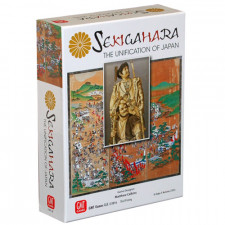Sekigahara: The Unification of Japan Review
on Dec 22, 2016
Wargames are a bit of a niche in the tabletop gaming world, and block wargames, perhaps even more so. Block games have players pushing around one-sided, well, blocks, hiding unit quality and quantity from the opposing player. The genre creates a fog-of-war effect, much like classic mass-market strategy game Stratego and countless variations thereof.
The trouble with block games is they are very hard to do well, since fog of war is useless if players can tell without too much trouble whether or not they’re going to win a battle. I’m not going to push my two measly blocks into battle against your eight blocks, no matter what kind of units they happen to be. They also can be tough to play well, at least at first.
So good block wargames must introduce a second means of restricting players’ command and control of their units, and this is where players will start to see the beauty of Sekigahara. Reflecting the treachery and constantly shifting loyalties in the real-life period of political intrigue in Japan, the design doesn’t allow players to actually send units into the fray until they have cards matching that clan in their hands. While players can spend cards to send any unit prancing about the map, once the battle lines are drawn, it’s entirely possible they’ve lost the persuasion needed to convince their fickle warlords to charge into the breach.

Adding to the pain, the game’s cards have multiple uses, so a player’s hand of cards will want to pull him in all kinds of different directions. A good player must know when to give up good opportunities in favor of great ones, as in many classic wargame designs.
All this means that sessions are filled to the brim with tension. I’ve got plenty of Uesugi cards now, but if I spend an extra one to force march, I’ll only have two for the battle. Is that enough? Do I risk a Loyalty Challenge now? He’s spent quite a few Maeda cards—surely he’s out by now! These kinds of decisions fill each session with a delightful sense of agony, in the best sense possible.
As with all my favorite wargames, Sekigahara manages to keep the rules overhead to a minimum. There are still plenty of historical exceptions and enough chrome for Japanese history buffs to sink their teeth into, but the core of the game is smooth as can be. Players use their cards to bid for turn order, then take turns moving and initiating combat twice in a row before starting the next year with a fresh wave of reinforcements and precious cards, gaining a bonus in their cards and forces if they control the most of the contested castle and resource spaces on the board. In a nutshell, that’s the structure—no goofy phases you forget every other turn, and no wild exceptions that force you back to the rulebook every five minutes. It’s clean, as all wargame designs should be.

Combat has been the downfall of many a wargame. So many of these kinds of games have a great setup and structure, and are just bogged down by a combat system that’s too big for its britches. Sekigahara couldn’t be further from this, with a simple system of one-upping your opponent’s last bid until one player passes or can no longer respond with a matching block-card combination. It works really well, with small battles being resolved quickly and larger confrontations not taking that much longer. The game throws in a few wrinkles with special unit abilities such as gunpowder and cavalry, as well as the ability for smaller forces to pull back into a siege, betting their opponent can’t muster up enough manpower to overrun the castle walls.
Every inch of the design is crafted with the intention that players are constantly forced to outthink one another, and aren’t distracted with minutia and endless modifiers that just take away from the action on the board. Good players will see great opportunities to attempt to assassinate their opponent’s ruler and end the game early, or else will discern when the time’s right to wait their foe out until the clock runs out, holding onto key victory point locations until the bitter end.
Sekigahara is the perfect blend of tense card play and historical flavor. Fans of block games are simply going to love pushing around the game’s gold and black blocks while their brain fires on all cylinders, trying to see the point of weakness in the enemy line while struggling to rein in one’s own forces with the fickle hands of cards. And history buffs will love the game’s quasi-realistic take on the era of turmoil and bloody conflict across 16th-century Japan. It doesn’t get any better than this.

 Customer Support
Customer Support  Subscribe
Subscribe 




 Account
Account  Wishlist
Wishlist 

